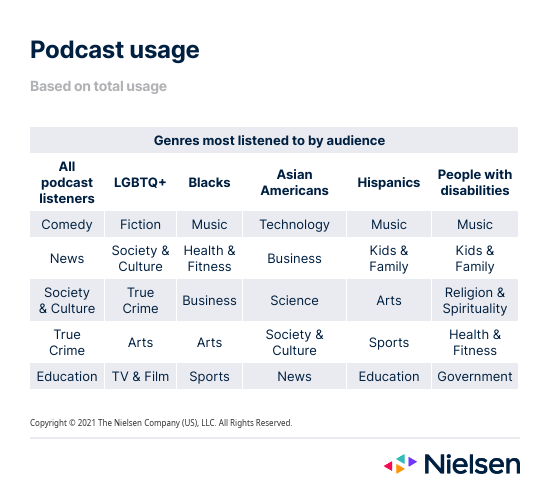The rise in podcast popularity over the last decade has effectively changed the landscape of the entire market. And the booming interest in new, engaging content has proven to be an attractive option among media consumption—particularly for diverse audiences.
Nielsen’s Seen on Screen 2021 report examines the importance of quantity and quality of on-screen representation for diverse identity groups. Specifically, how and how often different identity groups show up in content—and where within the storyline or subject—matters. Yet, much of today’s media still centers on one perspective or experience, with representation often addressed as a complement to a main story or primary character. As people look for content to accurately articulate and illustrate their lived experience, there are a burgeoning number of options, especially when you consider audio platforms. Importantly, for diverse audiences, podcast content is resonating and an important medium.
Nielsen Podcast Buying Power data shows:
- Average number of times per month each identity group listens to a podcast: ranges from 9 to 12 times per month between Asian American, Black, Hispanic, people with disabilities and LGBTQ+ podcast consumers
- Average weekly hours spent listening to podcasts: approximately 3 hours for each group
- What percentage of each identity group listens most often at home: people with disabilities are the highest (67% listen most often at home) with Asian Americans the lowest (43% listen most often at home)
Below are the podcast genres most listened to by audience:

Podcast popularity is growing
Blacks
Just as essential as the Black hitmakers, is the community commentary that elevates them—a trend that points to why podcasts are growing in Black listenership and audience investment. Black listeners are streaming audio more than other audiences, while listening more closely when brands reach out—averaging a 73% brand recall for podcast ads.
Hispanics
Hispanics are a diverse intersectional group with different experiences, perspectives and expectations. They want fresh, meaningful, culturally relevant content served up through trusted platforms. And podcasts are now a go-to platform for Hispanics to find that diverse content reflective of their experiences—and the podcasters that best engage them. As such, podcast listening among Hispanics 25-39 has doubled in the last three years.
Asian Americans
From the unique Asian American experience to relevant comedy, the availability of content that culturally speaks to Asian Americans is a key reason the number of podcast listeners has grown 5x over the last decade. Like in TV, news is among the top genres, and this is likely to continue as there is still uncertainty about the pandemic, along with Asian audiences staying tuned to the latest on the social justice movement.

The transformation toward increased engagement of podcasts over the last decade has created the opportunity for all audiences to find more content that resonates. And while the positive momentum of podcasting is enticing more celebrity involvement and even fueling original TV content, podcasts are attracting big ad dollars. The Interactive Advertising Bureau (IAB) is predicting that ad revenue will hit $2 billion by 2023, well above the $842 million generated last year.
Notably, podcast advertising—particularly when read by the host—drives stronger brand recall punch than more traditional forms of advertisements. For example, Nielsen’s Podcast Ad Effectiveness (PAE) solutions have found that host-read ads drive a brand recall rate of 71%, which subsequently creates high levels of consumer interest, purchase intent and recommendation intent.
Specially for diverse audiences, content that connects isn’t just on-screen; these audiences want to hear from trusted voices with similar backgrounds or that have similar interests. Most importantly, the topics need to be inclusive and of interest—from credible sources with original voices. And as podcasts more authentically appeal to a wide range of audiences, brands and agencies can track engagement with them and leverage targeted opportunities within their marketing strategies and campaigns.
Related content:
- Podcasting today report
- Being Seen on Screen microsite



